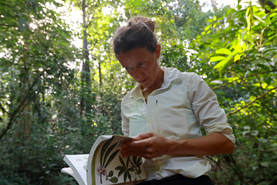
Daisy Dent
Alexander von Humboldt Fellow: Max Planck Institute of Animal Behavior, Germany
ETH Zurich, Switzerland
Smithsonian Tropical Research Institute, Panama
I completed my PhD at the University of Aberdeen, with field work in Sepilok Forest Reserve, Sabah investigating the basis for habitat specialisation in dipterocarp trees.
My research investigates how deforestation and forest fragmentation modify the composition of tropical tree and bird communities, and the impacts on ecosystem functioning, with projects in Panama, Brazil, Gabon and Malaysia.
In Panama, I am working with collaborators from Panamanian, US and UK institutions, to describe changes in the composition of trees and birds over forest succession in a network of permanent secondary forest plots. We are also investigating how ecosystem processes, such as above- and below-ground carbon storage, change overtime in secondary forests. This study is part of the 2ndFOR network, which spans > 60 secondary forest sites across the Neotropics, with the aim to identify broad relationships between forest composition, carbon storage and secondary forest age.
Alexander von Humboldt Fellow: Max Planck Institute of Animal Behavior, Germany
ETH Zurich, Switzerland
Smithsonian Tropical Research Institute, Panama
I completed my PhD at the University of Aberdeen, with field work in Sepilok Forest Reserve, Sabah investigating the basis for habitat specialisation in dipterocarp trees.
My research investigates how deforestation and forest fragmentation modify the composition of tropical tree and bird communities, and the impacts on ecosystem functioning, with projects in Panama, Brazil, Gabon and Malaysia.
In Panama, I am working with collaborators from Panamanian, US and UK institutions, to describe changes in the composition of trees and birds over forest succession in a network of permanent secondary forest plots. We are also investigating how ecosystem processes, such as above- and below-ground carbon storage, change overtime in secondary forests. This study is part of the 2ndFOR network, which spans > 60 secondary forest sites across the Neotropics, with the aim to identify broad relationships between forest composition, carbon storage and secondary forest age.
PhD Students

Alex Elsy
Project: The Impact of Liana Proliferation on Recovery of Biomass in Secondary Tropical Forests.
Cosupervised by Dr Marion Pfeifer, Newcastle University
Email: [email protected]
Secondary forests are increasingly common across large areas of the tropics. These forests are incredibly valuable for biodiversity and ecosystem function, and thus far much research has been focused on how secondary forests grow and recover from previous land uses over the early stages of succession. However, far fewer studies have examined how forest communities continue to change in mid-to-late succession. Our research aims to address this gap by investigating community and functional composition changes, in both liana and tree communities, across a secondary forest chronosequence (40 – 120 years old) in the Barro Colorado Nature Monument, Central Panama. This research will further understanding on how long late-successional forest communities take to recover to old growth levels and will add to the small body of literature around liana communities in late succession. Network analyses will help to unpick relationships between tree and liana communities and aid us in understanding liana colonisation preferences.
Project: The Impact of Liana Proliferation on Recovery of Biomass in Secondary Tropical Forests.
Cosupervised by Dr Marion Pfeifer, Newcastle University
Email: [email protected]
Secondary forests are increasingly common across large areas of the tropics. These forests are incredibly valuable for biodiversity and ecosystem function, and thus far much research has been focused on how secondary forests grow and recover from previous land uses over the early stages of succession. However, far fewer studies have examined how forest communities continue to change in mid-to-late succession. Our research aims to address this gap by investigating community and functional composition changes, in both liana and tree communities, across a secondary forest chronosequence (40 – 120 years old) in the Barro Colorado Nature Monument, Central Panama. This research will further understanding on how long late-successional forest communities take to recover to old growth levels and will add to the small body of literature around liana communities in late succession. Network analyses will help to unpick relationships between tree and liana communities and aid us in understanding liana colonisation preferences.
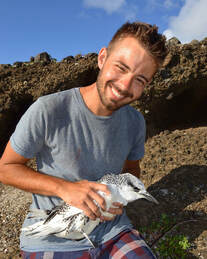
Adam Fell
Project: Maintenance of tropical forest bird communities in human-modified landscapes
Cosupervised by Prof Steve Willis, University of Durham and Dr Thiago Silva, University of Stirling
Email: a[email protected]
My particular interests lie with how animals react to the changing world and how they can alter
their behaviours in response to this. My current PhD project focuses on understanding how forest fragmentation affects bird behaviour in the tropical landscapes of Panama. Interactions between fruiting trees and their frugivores are integral to the maintenance of tree populations across degraded landscapes. Currently very little is known about how birds disperse and shift movement patterns with regards to habitat fragmentation and as such, we lack the capacity to predict how
this will impact on seed dispersal. We predict that species life history and morphological traits will interact with landscape composition to determine dispersal among forest fragments. We aim to
tag multiple bird species from distinct groups (canopy and understory frugivores and insectivores) with state of the art GPS loggers to monitor movement patterns across multiple landscape types
Project: Maintenance of tropical forest bird communities in human-modified landscapes
Cosupervised by Prof Steve Willis, University of Durham and Dr Thiago Silva, University of Stirling
Email: a[email protected]
My particular interests lie with how animals react to the changing world and how they can alter
their behaviours in response to this. My current PhD project focuses on understanding how forest fragmentation affects bird behaviour in the tropical landscapes of Panama. Interactions between fruiting trees and their frugivores are integral to the maintenance of tree populations across degraded landscapes. Currently very little is known about how birds disperse and shift movement patterns with regards to habitat fragmentation and as such, we lack the capacity to predict how
this will impact on seed dispersal. We predict that species life history and morphological traits will interact with landscape composition to determine dispersal among forest fragments. We aim to
tag multiple bird species from distinct groups (canopy and understory frugivores and insectivores) with state of the art GPS loggers to monitor movement patterns across multiple landscape types
Postdocs

Carolina Bello
ETH Zurich
Email: [email protected]
My current research project explores the effects of animals on tropical forest restoration, with a focus on seed dispersal. I aim to understand how frugivorous birds drive forest recovery in open areas by integrating data from different stages of the frugivory process (i.e., diet, movement, gut passage time). In this way we can predict the potential contribution of birds
to forest regeneration and carbon stock potential in degraded tropical landscapes. More broadly, I study the process of seed dispersal and its impact on potential forest carbon
stocks using frugivore interactions. I have shown that the loss of large frugivores reduces potential carbon storage in tropical forests due to reduced dispersal of large-seeded trees (Bello et al. 2017). In addition, I found that the potential of restoration projects to mitigate climate change is compromised when they do not incorporate animal dispersed tree species with high carbon storage potential (Brancalion et al. 2018).
ETH Zurich
Email: [email protected]
My current research project explores the effects of animals on tropical forest restoration, with a focus on seed dispersal. I aim to understand how frugivorous birds drive forest recovery in open areas by integrating data from different stages of the frugivory process (i.e., diet, movement, gut passage time). In this way we can predict the potential contribution of birds
to forest regeneration and carbon stock potential in degraded tropical landscapes. More broadly, I study the process of seed dispersal and its impact on potential forest carbon
stocks using frugivore interactions. I have shown that the loss of large frugivores reduces potential carbon storage in tropical forests due to reduced dispersal of large-seeded trees (Bello et al. 2017). In addition, I found that the potential of restoration projects to mitigate climate change is compromised when they do not incorporate animal dispersed tree species with high carbon storage potential (Brancalion et al. 2018).
Past PhD Students

Robin Hayward
Project: Long-term recovery of species diversity and community composition in selectively-logged tropical forests.
Cosupervised by Prof David Burslem, University of Aberdeen and Dr Lindsay Banin, Centre for Ecology and Hydrology, Edinburgh
Current Position: Communications and Engagement Officer, Leeds Ecosystem, Atmosphere and Forest Centre (LEAF), University of Leeds
Project: Long-term recovery of species diversity and community composition in selectively-logged tropical forests.
Cosupervised by Prof David Burslem, University of Aberdeen and Dr Lindsay Banin, Centre for Ecology and Hydrology, Edinburgh
Current Position: Communications and Engagement Officer, Leeds Ecosystem, Atmosphere and Forest Centre (LEAF), University of Leeds
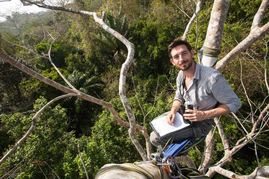
Tom Bradfer-Lawrence
Project: The maintenance of tropical bird communities in human-modified landscapes
Cosupervised by Prof. Steve Willis, Durham University and Prof. Nils Bunnefeld, University of Stirling
Current Position: Postdoctoral Research Fellow, University of Stirling, UK
Project: The maintenance of tropical bird communities in human-modified landscapes
Cosupervised by Prof. Steve Willis, Durham University and Prof. Nils Bunnefeld, University of Stirling
Current Position: Postdoctoral Research Fellow, University of Stirling, UK
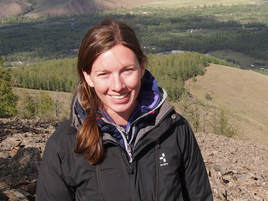
Rebekah Mayhew
Project: The species and functional composition of bird communities in regenerating tropical forests.
Cosupervised by Dr Joe Tobias, Imperial College London and Prof. Kirsty Park, University of Stirling.
Current Position: Land Management Adviser at Loch Lomond & The Trossachs National Park
Project: The species and functional composition of bird communities in regenerating tropical forests.
Cosupervised by Dr Joe Tobias, Imperial College London and Prof. Kirsty Park, University of Stirling.
Current Position: Land Management Adviser at Loch Lomond & The Trossachs National Park
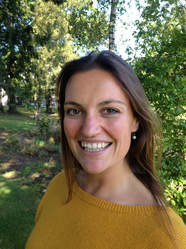
Isabel Jones
Project: Impacts of landscape-scale habitat fragmentation and dynamics of regenerating tropical forests.
Cosupervised by Prof Carlos Peres, University of East Anglia.
Current Position: UKRI Future Leaders Fellow, University of Stirling, UK
Project: Impacts of landscape-scale habitat fragmentation and dynamics of regenerating tropical forests.
Cosupervised by Prof Carlos Peres, University of East Anglia.
Current Position: UKRI Future Leaders Fellow, University of Stirling, UK
Co-supervised PhD students
Gustavo Alarcon Nieto with Kamran Safi (MPI-AB and University of Konstanz, Germany)
Claudio Manuel Monteza with Meg Crofoot and Mark Grote (MPI-AB, University of Konstanz, Germany and UC Davis, USA)
Abby Wallwork with Lindsay Banin and Emma Sayer (CEH Edinburgh and University of Lancaster)
Emma Bush with Nils Bunnefeld, Alistair Jump and Kate Abernethy (University of Stirling and Gabon National Parks Agency)
Kirsten Hazelwood with Tim Paine (University of Stirling)
Luci Kirkpatrick with Kirsty Park and Sallie Bailey (University of Stirling and Forestry Commission)
Gustavo Alarcon Nieto with Kamran Safi (MPI-AB and University of Konstanz, Germany)
Claudio Manuel Monteza with Meg Crofoot and Mark Grote (MPI-AB, University of Konstanz, Germany and UC Davis, USA)
Abby Wallwork with Lindsay Banin and Emma Sayer (CEH Edinburgh and University of Lancaster)
Emma Bush with Nils Bunnefeld, Alistair Jump and Kate Abernethy (University of Stirling and Gabon National Parks Agency)
Kirsten Hazelwood with Tim Paine (University of Stirling)
Luci Kirkpatrick with Kirsty Park and Sallie Bailey (University of Stirling and Forestry Commission)
